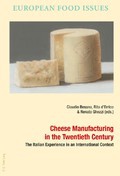RHN 182/2017 | Publication
Claudio Besana, Rita d'Errico and Renato Ghezzi (eds.), Cheese Manufacturing in the Twentieth Century.The Italian Experience in an International Context (European Food Issues/L’Europe alimentaire/Europa alimentaria/L’Europa alimentare 11), Bruxelles, Bern, Berlin et al.: Peter Lang 2017.
Since the end of the nineteenth century the dairy sectors of some industrialised European and American countries have experienced a phase of growth that took place at a different rate and in a different manner in each country, and which was made possible by the availability of raw materials and a more widespread knowledge of scientific and technological methods. The sector’s expansion was favoured by a revolution in transport networks, the beginning of globalisation in world markets and, decisively, by advances in packaging and refrigeration techniques. Italy in particular, despite its low availability of raw materials compared to other countries, rose quickly throughout the last century to become one of the largest international producers and exporters of cheese, especially of high value PDO cheeses. What factors were behind this achievement and which were the strengths and weaknesses of the sector during the twentieth century? The articles presented in this volume attempt to provide an answer to these questions from different points of view and using different interpretative approaches. The geographical range covered by these studies also reaches beyond Italy in order to look at other countries with relatively ancient dairy traditions. This comparative approach, although limited to just a few countries, is important in that it allows us to describe the evolution of a milk and dairy sector which has had such a large influence on the economic life of many regions in the Italian peninsula.
Source: https://www.peterlang.com
